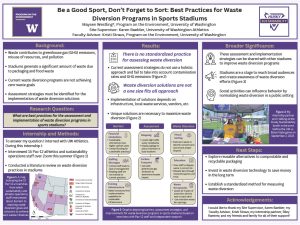BE A GOOD SPORT, DON’T FORGET TO SORT: BEST PRACTICES FOR WASTE DIVERSION PROGRAMS IN SPORTS STADIUMS
Waste contributes to environmental issues including greenhouse gas emissions, misuse of finite natural resources, and pollution that negatively impacts environmental and human health. While sports stadiums are a source of entertainment for many, they generate a substantial amount of waste. Currently, Husky Stadium diverts approximately 75% of its waste from the landfill using composting and recycling, however, increasing waste diversion can further reduce the environmental footprint of the facility. This study aims to identify strategies for the assessment and implementation of waste diversion in Husky Stadium to increase its waste diversion rate. To address this, I interned for UW Athletics and interviewed 15 operations and sustainability staff from the PAC-12 conference to collect data on barriers to implementation, methods for assessment of waste diversion programs, and solutions to improve waste diversion efforts. Additionally, I conducted a literature review to examine how other stadiums implemented diversion strategies in their operations. Findings indicate that effective strategies for assessment include mapping high-traffic waste receptacles and conducting an analysis of greenhouse gas emissions. I also found that waste diversion rates can be increased by implementing strategies including utilizing visual sorting, educating fans and staff, and implementing innovative waste receptacle features. These findings are significant to my host organization because they allowed me to produce a summary of recommendations to be implemented in Husky Stadium and to be shared with other collegiate athletic programs. Utilizing these strategies is essential for improving waste diversion programs and reducing the impacts of sports facilities on the environment.
